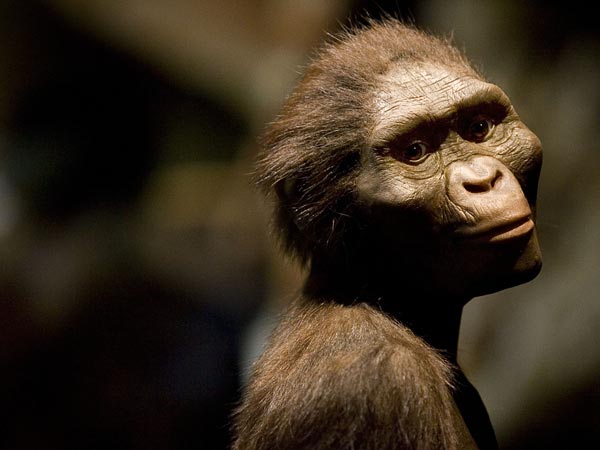"Lucy's Baby" a Born Climber
Looking up? Adult A. afarensis too may have been adapted to tree life (artist's reconstruction).
What made us human? Part of the answer may rest on the shoulders of a 3.3-million-year-old toddler.
Like "Lucy," the fossil child was a member of the species Australopithecus afarensis, pioneers of upright walking. Yet her apelike shoulder blades hint that our forebears may have taken longer than we thought to fully come down to earth, a new study says.
Figuring out when the tree-to-ground transition took place is immensely important to understanding how we became who we are. Bipedalism, after all, gave prehumans a literal head's-up on approaching predators and freed up hands for stone tools, which in turn gave access to more types of food, including brain-boosting animal proteins—among other advantages.
The tiny fossils—including the only known complete A. afarensis scapula, or shoulder blade—add to evidence that that giant stride was more a series of faltering steps.
"What we're showing is that bipedalism wasn't this sudden change that took shape in an early common ancestor," said study co-author David Green, an anatomy professor at Midwestern University in Downers Grove, Illinois.
"As bipedalism was developing, there were other forms of locomotion that were still important."
Clinging to the Branches of the Human Family Tree?
"Selam," or "Lucy's baby," or "Dikika baby"—as the A. afarensis three-year-old has been variously nicknamed—spent millions of years encased in rock in Ethiopia's Dikika region, where the shady forests she knew have long since given way to desert.
After discovering Selam in 2000, Zeresenay Alemseged spent 11 years flecking away sandstone to free what remained of her bones. For the new study, the California Academy of Sciences anthropologist and colleagues compared her fossils with those of living apes, humans, and other early human species.
The team found that the sockets of Selam's shoulder joints point upward, as they do in apes. Likewise, the bony ridge that runs along her shoulder blades is set at a similar angle as in chimpanzees.
These apelike shoulders, along with previously recognized climbing-friendly features, would have allowed Australopithecus species to do a number of things better than humans: raising their arms above their heads, hanging from branches, plucking fruit, and hoisting their bodies into trees.
"The fact that they still maintained the gorilla-like scapula, the long and curved fingers, the short clavicles [collarbones], and a torso which would probably have been funnel shaped, is testament to the presence of an arboreal lifestyle in addition to being fully bipedal," said Alemseged, a National Geographic Society emerging explorer.
In other words—whereas humans can climb trees, if we put our minds to it—A. afarensis was likely truly at ease in the trees and on the ground, according to the study, published Friday in the journal Science.
Case closed? Not quite.
A Puzzle Piece, but What's the Big Picture?
According to University of Missouri paleoanthropologist Carol Ward, the study "provides more evidence of the primitive nature of these animals, so that's really exciting, and it's a key piece of the puzzle."
Ward agreed that the shoulder development of the growing A. afarensis "doesn't seem particularly humanlike." But, she added, "it's hard to know exactly what that means."
Some of the shoulder measurements of adult australopithecines in the study, she said, seem similar to those for human species, especially Neanderthals. And "Neanderthals are very clearly not climbing trees."
Study co-author Green conceded that one adult Australopithecus specimen from Ethiopia has a shoulder blade ridge with an apparently more horizontal, humanlike angle. But, he countered, two Australopithecus shoulder bones from South Africa "are even more apelike than afarensis'."
"Great Fossil" but No Smoking Gun
Scott Simpson, a paleoanthropologist at Case Western Reserve University in Cleveland, said Selam is "a great fossil."
"But," he added, "I don't think it's the smoking piece of information that says these guys were climbing trees."
The "transition to bipedality caused a complete reorganization of the body," altering the pelvis, various knee and ankle bones, the spine, and the foot, he said. But this new analysis "hinges on a very narrow part of the musculoskeletal system."
If the study had taken in the whole skeleton, he said, "I think we would learn a lot more about what's going on."
Green, the study co-author, responded that shoulder blades "have been shown in primates and in mammals to be a very reliable indicator of an animal's locomotor and behavioral habits."
"As far as looking at the whole body," he added, "it's something we're planning."
A. Afarensis No Match for a Chimp
Despite their differences, the researchers agree on the basics: A. afarensis was an upright walking creature that also climbed trees.
Case Western's Simpson thinks they probably climbed like modern humans, "as opposed to exhibiting any special adaptations to arboreality."
The University of Missouri's Ward agreed, arguing that, if climbing were part of A. afarensis' lifestyle, evolution would have left the species with "the really key bits of climbing anatomy, like the grasping foot."
Another thing they can all agree on: A. afarensis would have been no match for a chimp or gorilla in negotiating the forest canopy, as study co-author Alemseged pointed out.
But Alemseged maintains that the species was nevertheless a natural climber. In the trees, its apelike shoulders, long fingers, and other adaptations, he argues, would have allowed it to overcome the handicap of a bipedal body.
Good thing, too. "A species of small stature with almost no technology, which feeds on leaves and fruits and lives in a very dangerous world, needs to nest, evade predators, and to feed itself," he said.
"For those reasons"—in addition to the fossil evidence—"I think an arboreal lifestyle was an important and key element of Australopithecus afarensis."
James Owen
for National Geographic News
Published October 26, 2012












